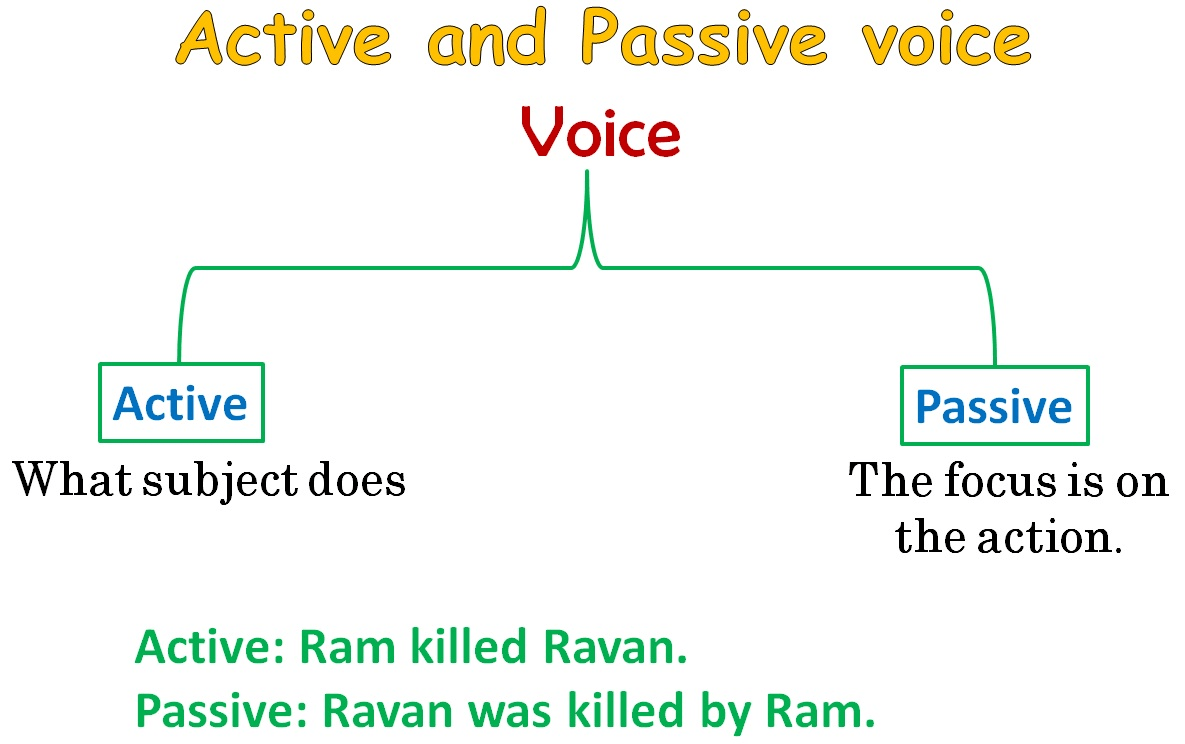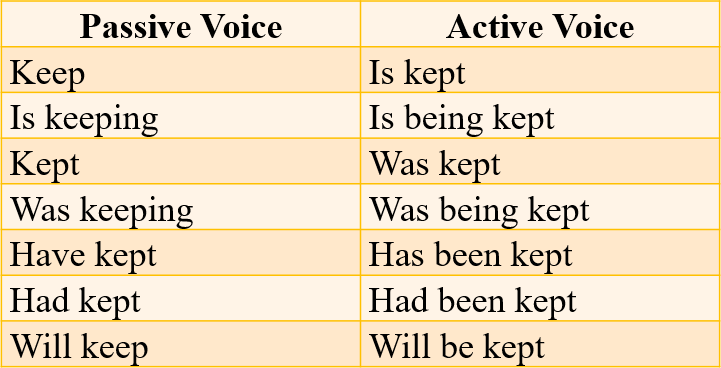Active & Passive Voice
The voice of a verb expresses whether the subject in the sentence has performed or received the action.
Types of Voices of Verb
Verbs have two voices
• Active Voice
• Passive Voice

Active Voice - When an action performed by the subject is expressed by the verb, it is an active voice. Active voice is used when more straightforward relation and clarity is required between the subject and the verb.
Example:
• Hens lay eggs.
• Birds build nests.
Passive Voice - When the action expressed by the verb is received by the subject, it is passive voice. Passive voice is used when the doer of the action is not known and the focus of the sentence is on the action and not the subject.
Example:
• Eggs are laid by hens.
• Nests are built by birds.
Conversion of Active and Passive voice example
Active Voice: Rita wrote a letter. (Subject + Verb + Object)
Passive Voice: A letter was written by Rita. (Object) + (auxiliary verb) + (past participle) + (by subject).
Rules for Active & Passive Voice Conversions
Rule 1: Identify the (S+V+O) Subject, Verb and object in the active sentence to convert to passive voice.
Example: He drives car. (Subject - He, Verb - Drives, Object - Car)
Rule 2: Interchange the object and subject with each other, i.e. object of the active sentence become the subject of the passive sentence.
Example:
Active Voice: She knits sweater. (Subject - She, Verb - Knits, Object - Sweater)
Passive Voice: The sweater is knitted by her. (Object sweater is interchanged with the subject “She”).
Rule 3: Change the base verb in the active sentence into the past participle i.e. third form verb in a passive sentence i.e. preceded by (by, with, to, etc). Base verbs are never used in passive voice sentences.
Example:
• Active voice: She prepares dinner.
Passive voice: The dinner is prepared by her.
• Active voice: She knows him.
Passive voice: He is known to her.
• Active voice: Juice fills the jar.
Passive voice: The jar is filled with juice.
Rule 4: While conversion of Active Voice sentence to Passive Voice sentence, the pronoun used in the sentence also changes in the following manner.
I - Me
We - Us
He - Him
She - Her
They - Them
You - You
It - It
The third form of the verb (V3) or past participle is used as main verb in passive voice. Auxiliary verb differs for each tense.

Changing Interrogative sentences into the Passive
The primary auxiliary verbs do, does or did does not appear in the passive form.
The verbs has, have, had, will, shall, can, may etc., do not change their position at the beginning of the sentence when the active voice is changed to the passive voice.
The question words when, why, where, how or what does not change their position at the beginning of the sentence when the active voice is changed into the passive voice. Note that who changes to by whom and whom into who.
Do/Does - is/are
Did - was/were
Has/have/had - been
Active voice: Did she recognize you?
Passive voice: Were you recognized by her?
Active voice: Can anybody cure it?
Passive voice: Can it be cured (by anybody)?
Active voice: Who wrote this book?
Passive voice: By whom was this book written?
Active voice: Have you finished work?
Passive voice: Has the work been finished by you?
Active voice: When will they announce the results?
Passive voice: When will the results be announced (by them)?
Active voice: Have you invited them?
Passive voice: Have they been invited by you?
Active voice: Will you help him?
Passive voice: Will he be helped by you?
Active voice: What did he say?
Passive voice: What was said by him?
Active voice: Whom did you invite?
Passive voice: Who was invited by you?

No comments:
Post a Comment